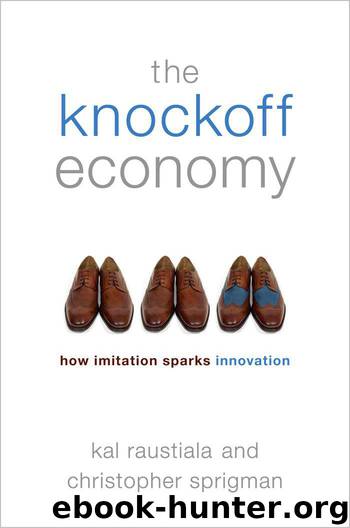The Knockoff Economy by Kal Raustiala & Christopher Sprigman

Author:Kal Raustiala & Christopher Sprigman
Language: eng
Format: mobi
Publisher: Oxford University Press, USA
Published: 2012-03-04T05:00:00+00:00
FIGURE 4.1 Helvetica vs. Arial
As this shows, Helvetica and Arial are not identical. They are certainly alike enough, however, that if the general rules of copyright applied, Arial would almost certainly be judged “substantially similar” to Helvetica—and therefore illegal. But copyright does not apply in the world of fonts. Its absence has allowed the wide proliferation of subtle variations on popular fonts. The ordinary consumer may overlook these variations, but for the graphic designer looking for just the right font for a particular job, they are invaluable.
Another familiar, yet very different, font is Times New Roman.* Times New Roman was designed to be highly legible using the crude newspaper printing techniques prevalent in the early 20th century, and to take up less space than comparably legible fonts.
Here is a sentence set in Times New Roman.
The impression this font gives is entirely different from Helvetica’s. Where Helvetica is clean and modern, Times New Roman is stately and suggests solidity and credibility—exactly the impression that a “newspaper of record” wishes to make. It is not surprising, then, that there are many variations on Times New Roman. A popular example is Georgia, a design commissioned in 1993 by Microsoft. Georgia is adapted from Times New Roman but with wider serifs. Again, Georgia is similar enough that it would almost certainly break the law if copyright law applied to fonts. The absence of copyright, however, allows designers to imitate fonts like Times New Roman and create subtly different, but overall very similar, families of fonts.
Fonts and Copyright
Fonts, like recipes, and fashion designs, can be freely and legally copied. They are excluded from copyright protection for a lot of the same reasons fashion designs and recipes are. For purposes of copyright law, fonts fall within the category of “pictorial, graphical, or sculptural works.” These are not protected if they are “functional,” and fonts are considered functional in the simple (or perhaps simpleminded) sense that they are used to construct words and sentences. But for fonts, there would be no books.
Though fonts are clearly functional in this narrow sense, they may still be protectable by copyright if their aesthetic appeal is “separable” in some way from their utilitarian purpose—much like the jewelry designs we discussed in Chapter 1. But given that fonts, to perform their function, must be legible, the utility of fonts is pretty much unavoidable. When Congress passed the current copyright law, the accompanying report from the House of Representatives recognized this basic fact, stating that the relevant committee “does not regard the design of a font… to be a copyrightable ‘pictorial, graphic, or sculptural work’ within the meaning of this bill and the application of the [separability] dividing line.”15 In the years since, the United States Copyright Office has refused to register font designs. The few cases that have considered the issue have followed suit, ruling that fonts are uncopyrightable.16
So fonts are unprotected by copyright law.* Is there any law that does protect them against copying? In theory, a truly original font could be protected by a design patent, but for practical reasons patent has only marginal relevance.
Download
This site does not store any files on its server. We only index and link to content provided by other sites. Please contact the content providers to delete copyright contents if any and email us, we'll remove relevant links or contents immediately.
You Don't Own Me by Orly Lobel(1407)
Intellectual Property Strategy by John Palfrey(1385)
Hello, My Name is Awesome by Alexandra Watkins(1325)
Without Copyrights by Spoo Robert(1311)
Profit From Your Idea: How to Make Smart Licensing Deals by Attorney Richard Stim(1299)
The Trademark Guide by Lee Wilson(1203)
Democracy of Sound by Alex Sayf Cummings(1187)
A Triumph of Genius: Edwin Land, Polaroid, and the Kodak Patent War by Ronald K. Fierstein(1170)
The Copywriter's Handbook by Robert W. Bly(1136)
Kafka's Last Trial by Benjamin Balint(1135)
World War 3.0 by Ken Auletta(1122)
Data Protection: A Practical Guide to UK and EU Law by Carey Peter(1107)
What They'll Never Tell You About the Music Business by Peter M. Thall(1064)
BVR's Guide to Intellectual Property Valuation by Michael Pellegrino(1050)
The Tech Contracts Handbook: Software Licenses and Technology Services Agreements for Lawyers and Businesspeople by David Tollen(1046)
Mass Media Law by Pember Don & Pember Don(1042)
Hello, My Name Is Awesome: How to Create Brand Names That Stick (BK Business) by Alexandra Watkins(1033)
Patent It Yourself: Your Step-by-Step Guide to Filing at the U.S. Patent Office by Pressman David Attorney(1032)
The New Censorship: Inside the Global Battle for Media Freedom by Joel Simon(1013)
